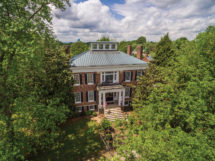If you’re looking for Halloween fun with fascinating history on the side, head to Richmond for the annual Ghost Walk at White Hall State Historic Site. For at least the past 15 years, Eastern Kentucky University’s theater department has staged “historic snippets” in various rooms of the house and on the grounds during haunting season. Often featuring the home’s famous Clay family, performances can run the gamut from a chatty family member to an exciting recreated duel.
Park Manager Kathleen White chuckles. “It’s a fun Halloween activity, but not the jump out, chainsaw, scare-you-to-death type.”
All the scenes employ “voices” from the past and play on the fact that the house may actually house restless spirits.
“There’s something that goes on here,” White said. “I hesitate to say it’s haunted because it’s all in how you view it. But there are things I’ve seen, things I’ve heard, smells I’ve smelled out of the ordinary that I cannot explain.”
White Hall’s big story, however, revolves around its famous family.
The stately brick abode is really two houses in one. Named Clermont, the original Georgian structure was built in 1799 by General Green Clay, who came to Kentucky as a young man with Daniel Boone. Through surveying, he amassed a huge amount of property. He grew hemp, raised sheep and owned distilleries, mills, taverns, farms and a ferry across the Kentucky River. In the early 1860s, Cassius Marcellus Clay expanded the home from seven to 44 rooms after inheriting it from his father and chose the name White Hall.
One designer in that renovation was noted architect Thomas Lewinski, who also renovated Ashland, the home of Clay’s cousin, Henry, in Lexington. Obvious similarities in the two residences include tall, browed Italianate windows, enlarged cornices, iron balconies and porches, and indoor touches of Greek Revival. In addition, the Richmond mansion boasts a number of features unusual for its day: a central heating system fed by two basement fireboxes and indoor plumbing supplied by a hefty third-floor cistern that collected rainwater.
Cassius himself was a distinctive individual. Born in 1810, the outspoken emancipationist lived among slave owners in the slave-owning South. Inspired early on as a Yale collegiate by an anti-slavery speech delivered by abolitionist William Lloyd Garrison, Clay believed that slaves should be freed gradually by legal means. After earning a law degree from Transylvania, he began a career in politics, serving as state representative from Madison County in 1835 and 1837. (Clay’s daughter, Laura, followed her father’s lead, campaigning for women’s suffrage and states’ rights. In 1920, Laura Clay became the first woman to be nominated for president of the United States by a major political party.)
Praised for his oratorical acumen while raising controversy among pro-slavery factions, Clay also championed emancipationist ideals as editor of a newspaper, The True American. In 1844 he stumped for Henry Clay during the Lexingtonian’s unsuccessful run for president, an election won by James Polk.
In 1846, Cassius volunteered in the Mexican War, showing such bravery and care for his men that upon his return the people of Fayette County presented him with a Tiffany sword. In the 1850s, he befriended abolitionist preacher John G. Fee from Bracken County, giving him land, money and encouragement to start an area school for non-slaveholders. Thus Berea College was born.
After supporting Abraham Lincoln for president in 1860, Clay was appointed minister to the court of Czar Alexander II of Russia. In addition, the brilliant statesman and soldier headed the “Clay Battalion” that guarded Washington, D.C., until Federal troops arrived after Confederates had fired on Fort Sumter. Commissioned a major general, Clay became an emissary between the president and the Kentucky legislature, and his reports greatly influenced Lincoln’s signing of the Emancipation Proclamation in 1863. Because of his Russian connections, Clay was also instrumental in facilitating the U.S. purchase of Alaska.
Returning to White Hall in 1869, the Lincoln Republican switched parties due to Republican radicalism during Reconstruction. He and his wife of 45 years divorced, and at 83, he married the 15-year-old daughter of a local farmer, a union that last but a year.
Clay died in 1903 and was buried near White Hall. In 2000, he was inducted into the Kentucky Commission on Human Rights’ Civil Rights Hall of Fame. So respected was he in the African-American community that according to a recently unearthed newspaper story, local black mothers, children and elderly people paid their last respects by lining the streets on the way to the cemetery. Today, White Hall and its 13 acres stand as a wonderfully preserved testament to a life well lived.



















Add Comment